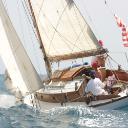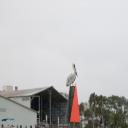Yahoo Answers is shutting down on May 4th, 2021 (Eastern Time) and beginning April 20th, 2021 (Eastern Time) the Yahoo Answers website will be in read-only mode. There will be no changes to other Yahoo properties or services, or your Yahoo account. You can find more information about the Yahoo Answers shutdown and how to download your data on this help page.
Trending News
What does the nautical term "lee shore" mean?
I've been reading Patric O'Brien and they keep mentioning it. I know it has to do with which way the wind is blowing in relation to the ship and the coastline, but I'm not sure.
Any sailors out there who know?
13 Answers
- Anonymous1 decade agoFavorite Answer
OK people. This is difficult to picture without drawing it out on paper. But Chapman’s Piloting & Seamanship manual, which is the mariners bible, defines “WINDWARD means toward the direction from which the wind is blowing……(same as) the WEATHER SIDE.” “Opposite to windward is the LEE SIDE of a boat is the side away from the wind”.
So, on a boat if we are on a course to the east and the wind is out of the north, the left/port side of our boat is the windward or weather side and the right/starboard side is the lee side of the boat. (You experienced sailors know to pee to the lee.)
On a lake, the upwind side would be the windward side OF THE LAKE (water). And the down wind side of the lake would be the lee side, again of the lake.
If we think about a peninsula jutting into a lake at a right angle to the wind, the side or shore onto which the wind is blowing should be the windward shore and the opposite side of the peninsula would seem to be the lee side. (Although I have never seen shores defined as windward or lee side.)
But, if you are in the lee of the land, you are on the upwind side of a body of water in the lee of the trees (for example) which are protecting you from the full force of the wind.
- Larry MLv 41 decade ago
A lee shore is the shore that the wind is blowing on to. It is named such due to the fact that it's on the lee side of the boat. It's an unfavourable position to be in as it is a great way to wreck your boat if you cannot "claw" your way off as mentioned above. This is why In the Patrick O'Brien stories they kept track of Lee Shores.
Don't confuse this with being in the "Lee" of an island, point of land, etc. Again it has nothing to do with how the wind is blowing across the boat but rather that you are on the opposite side of an obstruction from where the wind is coming from. Being in the Lee can be a very smart move in lumpy conditions. When anchoring for the night, I try to figure out what the weather conditions are coming from, how they'll swing over night and position the boat so that there's a land mass between me and the wind.
- Anonymous1 decade ago
Just to confuse things......It's relative to where you are
On an island, the side getting the wind is the windward side,
the other (lee side) is the sheltered side.
A boat travelling parallel to a windward shore w/ the shore on its lee side (away from the wind) which makes it a lee shore relative to the boat.
Turning hard alee will make the boat run with the wind & bunk into the island.
Not good if you are too close , under sail & cannot "claw" away.
Travelling parallel to the lee shore of an island (windward side of the boat facing shore) ,turning hard alee will take you away from shore.
Best regards
Source(s): Old "wind fairy" - cat38skipLv 61 decade ago
Mark T has it correct. An anchorage or land becomes dangerous and is referred to as a 'lee shore' when the wind blows onshore as viewed from the boat. It is the shore that is on the lee side of the boat but onto which the wind is blowing. If you are standing on the boat, lee means the side that is more protected and windward means the side onto which the wind blows.
- How do you think about the answers? You can sign in to vote the answer.
- Anonymous1 decade ago
Last year I watched a blue water 50 being blown toward lee shore. It had been purchased two weeks prior by a person
as liveaboard retirement and owner was twenty miles away
when mooring parted during windstorm. The dark blue 'glass hull pushed along with its port rail taking sea aboard until it hit rocky shore. As following seas crashed into lee shore the vessel began to break up within hours. This winter only some twisted wire and 'glass shards mark the location.
- science teacherLv 71 decade ago
The lee shore is the shore that the wind is blowing toward. There is some confusion because a boat in the lee is sheltered, but the lee shore is not the sheltered shore.
- Anonymous1 decade ago
The Leeward shore is the shore to which the wind blows (an on shore wind). The Windward shore is the shore from which the wind blows ( an off shore wind). In a storm, vessels give a leeward shore a "wide berth" to mitigate the chance of being driven aground and wrecked.
- yankee_sailorLv 71 decade ago
Mark T for first in and slit t for a clear answer.sailors ( of which I can claim the title, for I have 30,000 miles behind me and can, on a good day, remember th pointy end goes forward, don't like lee shores.a shore that is downwind of them.for if something goes cafllooy, you drift down on the shore.
Jack would especially dislike a lee shore close by in a breeze, for he would usually have to turn Surprise by wearing, or jibing her; turn downwind to change course 180 degrees, which brings you closer to shore and a really bad caphlooy. ( Eng version of calflooy)
Congrats on discovering O'Brien; three are some parts you have to go through in 4 wheel low gear; but the man is a fantastic writer and more than once, going through the books, I have been struck dumb with admiration for his craft.
You mat also like to know:
In one of the early books intro, O'Brien says that almost none of what Jack and Steven do is fiction; he gathered it all from logs of the era t the National Maritime Museum. He's right; Aubrey is closely based on Sir Thomas Cochran, who took a 44 gun Spanish ship with his small brig, rose to Captain, dismissed the service for being framed in stock scandal, went to South America and lead the revolutionary Navies of Chile and Peru ( there are still warships in the Chilean Navy named for him), reinstated to the RN and retired as Admiral of the Fleet
Source(s): naval historian, Caribbean boatbuilder and sailor and on my third pass thru the 20 wonderful books.....still havent read the partial 21st though! - landfall43Lv 41 decade ago
Sorry Vince, Mark is correct, the Lee shore will be the on with the waves breaking on it. Sounds like it should be the other way around but it is not.
Source(s): Retired commercial mariner








